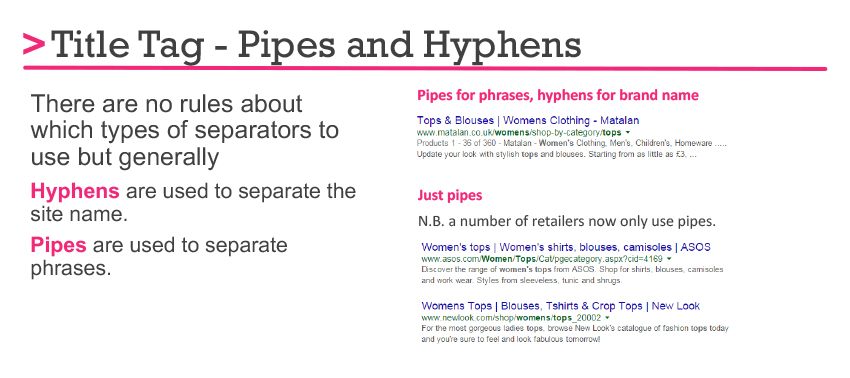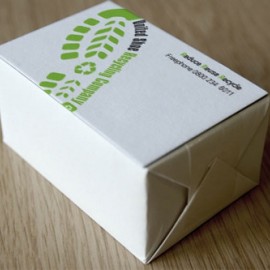An Introduction to SEO
31st May, 2017

Graphic showing Google and SEO
On Thursday 11th May, our graphic designer Fiona attended a bite-sized learning event organized by the Brighton & Hove Chamber of Commerce, hosted by the Sussex County Cricket Club.
The speaker, Peter Phillpot, the Commercial Director at SiteVisibility, presented an informative talk titled ‘Introduction to SEO’. Fiona went along for two reasons; the first reason is that she’s putting together a bite-sized session on web design, so she was hoping to pick up some presenting tips and secondly, as SEO is constantly evolving in line with search engines, it’s essential to keep up to speed with it all.
Peter began by detailing the rise of search engines and how Google capitalised the market with their PageRank algorithm, named after Larry Page, one of the founders of Google. Google’s PageRank algorithm is similar to how academic papers are rated. The theory is that the more citations a paper has, the higher the probability that that paper is informative, helpful and influential and Google wanted to rank websites in same way. According to Google:
"PageRank works by counting the number and quality of links to a page to determine a rough estimate of how important the website is. The underlying assumption is that more important websites are likely to receive more links from other websites."
It is not the only algorithm used by Google to rank search results, but it is the first algorithm that was employed by the company, and it is the best-known.
As well as checking your PageRank you might also like to monitor your website’s page strength. ‘Page strength’ is an SEO term used to describe the likelihood of your site being found by a search engine. Page strength is a rating out of 100 assigned to a web page based on a number of factors, such as the number of inbound links, quality of inbound links, social media shares and mentions and on-page SEO such as title tags and meta descriptions (more on this later). You can find out your website’s page strength rating using Moz’s free tool called Open Site Explorer. The free version enables you to check three pages per day. It’s worth noting that each page of your website is measured individually and usually your homepage will score best as it’s likely to contain a greater quantity of quality links and high ranking keywords compared to the inner pages of your website.
Peter suggested finding out your competitor's page strength rating to see if yours are similar and if their website rates higher than yours, it's worth investigating why. As you can imagine, you’ll want a higher page strength rating than your competitors, so customers are more likely to find your website when searching for your product or service before finding your competitor’s website. To widen your SEO knowledge, it’s worth reading Google’s SEO Starter Guide and to follow Google’s current general and quality guidelines. Following these guidelines will help Google, find, index and rank your site. The guidelines previously suggested submitting your site to relevant online directories such as the Open Directory Project and Yahoo! and to have other relevant sites link to yours. This led to Black hat SEO techniques being used to boost rankings such as auto directory submissions. Companies found ways to automatically submit their details to online directories, even employing workers in the Philippians to fill in captcha codes to complete the process. In doing so, companies could be listed on up to 4,500 directories in less than 20 minutes – that's a lot of links! Another black hat SEO tactic was to have bots, posing as real people. The bots would post questions on forums and then a few days later the bots would answer the questions posing as a different person linking to the website that wanted to improve it’s ranking, saying something along the lines of ‘I found (insert company’s name) really helpful, check out their website for more info…’ These bots could spam forums with up to 1.5 million links for a single company! These techniques meant that sites that weren't particularly informative, helpful or influential ended up ranking higher than those that were, but which didn't contain as many links or high ranking keywords.
In a bid to improve the quality of their search results Google devalued links from certain directories, even removing some directory listings from their index and penalising websites that do not adhere to their ‘Quality Guidelines'. Even global companies such as BMW and Interflora were banned from Google for a few days due to giving bloggers free products in return for good reviews and links. Thankfully, Peter detailed how you can find out if Google suspects your website is committing any violations by logging into your Google Search Console (used to be known as Webmaster Tools) and clicking on ‘Manual Actions' and hopefully no issues will be listed. If there are any, you can contact Google via a reconsideration request and apologise. As part of your apology, you'll need to explain the measures you have taken to combat any issues. It is worth noting that if you do have any issues, it's probably worth getting professional help to fix any problems. They can also advise on putting together a reconsideration request because if Google isn't happy with the action you have taken to rectify any issues, they do have the power to ban your website from Google listings.
So what SEO techniques do adhere to Google's Quality Guidelines? Thankfully there are various ways including link building and optimising title tags and meta descriptions using keywords.
Link building now requires a lot of hard work to produce informative, helpful and influential content that people will link to. Just creating quality content alone is not enough to get great links. You need to promote your content via social media, e-shots and digital press releases, etc. For content ideas, Peter suggested visiting the website answerthepublic.com where you can enter your keywords and it will generate a list of questions relating to them. For example, if you enter the keywords ‘web design' one of the 147 questions generated is ‘why is responsive web design important?' You could write a blog answering this question and promote it via your social media and an e-shot. Blogs titled with a question often have a higher click through rate due to people Googling a question to find the answer. A blog that poses a question can also capture your prospective customer's interest while they are scrolling through social media or their emails, encouraging them to click through to find out the answer. It's worth ensuring your blog contains lots of relevant keywords and details how your services or product can help your visitors, so when prospective customers are searching for the answer to ‘why is responsive web design necessary?', they're more likely to find your blog which details the benefits of responsive web design and that you offer responsive web design services. Just remember to end your blog with a call to action. It's also worth building up a network of highly regarded bloggers whose blogs are related to your field and who are happy to share your content. Consider that if you offer free products or services or pay for links from influencers in return for links you need to mark the links as ‘rel=nofollow'. This means that their link will not be counted towards your PageRank or page strength to appease Google, but should still drive visitors to your site as you've been recommended by trusted blogger/s.
Peter also detailed why duplicate content can be damaging to your website’s page strength. Duplicate content can arise when a website has ‘www’ listed in front of the URL as well as the URL without the ‘www’. The unwanted version needs to be redirect to the correct version. For example, Twitter’s URL is https://twitter.com/ without the ‘www’, and if you search for ‘www.twitter.com’ you’re automatically redirected to https://twitter.com/. If they had both running at the same time their page strength would be split between the two URLs, leading to two low ranking versions of the site.
As in the early days of search, keywords are still an important part of SEO. When creating on-page content it is important to find out what words and phrases your prospective customers are using to search for your product or services. These are your keywords and should be included in your title tags, meta descriptions and on-page content. One method of finding what keywords you need to use is by using Google’s Keyword Planner. You can enter your own URL or competitor’s URL, the name of your product/service or the category of your product/service and Google's Keyword Planner will generate a list of keywords and average monthly searches for each keyword. You can also access your site's search data via Google Search Console to monitor which keywords send traffic to your site and the number of impressions, clicks and other metrics.
In addition to Google’s Keyword Planner, there are many other free keyword tools such as keywordtool.io and ubersuggest.org which also generate lists of suggested keywords.
Peter also helpfully gave us tips on optimising title tags and meta descriptions. Title tags are the blue titles that appear in the search listings and generally a title tag that is 55 characters long will display without truncation, but there is no set character limit to adhere to. The limit is based on the width of the characters; therefore, you'll be able to fit in more words that are made up of thinner letters such as the letter ‘I' compared to letters such as ‘M’ and ‘W’. It's also advisable to capitalise keywords to help them stand out and put keywords at the beginning of your title tags. Plus, more and more websites are using pipes ‘|’, rather than hyphens ‘-’ to separate categories and brand names, etc. as they take up less space.

If you are unsure what title tags to use it’s worth checking out your competitor’s title tags which are ranking well. You can find out how your title tags display on Google using Moz’s free title tag preview tool. Meta descriptions, on the other hand, are not visible on the page but can be seen in the source code. Meta descriptions are not used by most search engines to determine ranking positions but can lead to a better CTR (Click Through Rate). Meta Descriptions should be keyword rich because keywords will appear as bold in search results. Typically, meta descriptions that are under 156 characters will be displayed in full on all devices. A tactic for increasing your CTR is to include a call to action in your meta description. Call to actions for e-commerce websites include ‘buy', ‘shop' and ‘get', whereas a call to action for brochure sites would include ‘discover' and ‘find out more' etc.
To sum up, Peter used his wealth of experience to present an informative and well-structured talk. He was able to gauge the level of experience of the attendees, so everyone was able to get something out of his talk. Plus, he added timings to his slides to help him keep on track, so he was able to cover everything as his talk was jam-packed with helpful SEO information.
So, although it's worth regularly reviewing your SEO efforts in a bid to out-rank your competition, please bear in mind that there's more to improving your online conversions than just SEO alone. To find out how you can generate more enquiries and increase online sales you need to secure a ticket to the Bite-sized session titled ‘Is your website working for you or against you' presented by our graphic designer Fiona, on the morning of the 30th August 2017. She will detail practical tips to help business owners and website editors to improve their websites. The topics she will cover will address issues such as:
- how to generate more enquiries and increase online sales
- how to ensure your website is easy to update
- how to check if your site is mobile friendly and easy to navigate
To address these issues, she will cover the importance of having a clear digital marketing strategy as well as an easy to use CMS (Content Management System) and why it's beneficial to regularly review your website design and structure. If you're interested in purchasing a ticket, please head to the Eventbrite page.






Comments
comments powered by Disqus